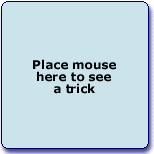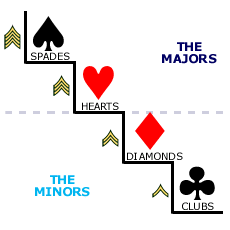|
LESSON
2
THE GAME OF BRIDGE
|
 |
|
Hello again! Welcome
to this new lesson.
|
 |
|
|
|
|
|
|
|
|
|
|

The
tricks are played in clockwise order, 13 times per
deal. Since everyone starts with 13 cards, by the time
the last trick is played (the last four cards), nobody has
any more cards left and the bridge hand is over.
|
 |
In the first lesson, we
discussed "tricks." A trick
is composed of four cards,
one card contributed by
each of the four players.
|
 |
|
|
|
|
|
|
|
|
|
|
When
you look at a deck of cards, you can see
that it's divided into four "suits" - that is,
each card has one of four symbols on it.
Move
mouse on the suit to see the symbol.
|
 |
Each "suit" -- the group
with the same symbol --
has 13 cards. And each
card
has a symbol on it.
Wait a second, I think
I repeated myself. Professor
Emceetwo! Are you there?
Help me, please!
|
 |
|
|
|
|
|
|
|
|
|
|
|
|
 |
Hi
there. Higher
mathematics, huh?
A deck of cards has
52 cards in it.
There are four suits,
each with 13 cards.
Four times 13 = ... ?
|
 |
|
|
|
|
|
 |
...
52.
Thanks, professor!
That was easy!
Now take a look at
the symbols again!
|
 |
|
|
|
|
|
|
|
Hearts
look like hearts and
diamonds look like diamonds,
and they are both red.
I guess the spade is
supposed to look like the
bottom of a garden tool,
and I have no idea why
the club is called a club;
it looks more like a
three-leaf clover to me.
The clubs and spades both
have little stems at the
bottom and both of them
are black.
In any case, we have two red
suits and two black suits.
|
|
|
|
 |
I
did not list the four
suits randomly. The
suits are "ranked," just
like officers are ranked in
the military.
Spades have the highest
ranking, followed by hearts,
then diamonds, and clubs
last of all.
|
 |
|
|
|

The
ranking of the suits is important only
in the bidding part of the game.
The suits are also divided into two categories;
spades and hearts are called "The Majors" and
diamonds and clubs are called "The Minors."
|
|
|
|
|
LESSON
2
QUIZ
|
 |
|
That's enough for this lesson.
Here's a quiz. Good luck!
|
 |
|
|
|
|
|
Questions
|
Move
over ?
for answer |
|
1. There are two parts to a bridge deal. What are they
called?
(A)
Diamonds & CLubs
(B) Bidding & Card Play
(C) Majors & Minors
(D) Dealing & Assorting
(E) Kissing & Smooching
|
 |
|
2. How many suits are there in a deck of cards, and how
many cards are in each suit?
(A)
4 suits, 13 in each suit
(B) 3 suits, 16 in each suit
(C) 3 suits, 18 in each suit
(D) 4 suits, 12 in each suit
|
 |
|
3. What are the names of the suits?
(A)
clubs, sticks, hearts and darts
(B) diamonds, rubies and saphires
(C) spades, hearts, diamonds and clubs
(D) reds, blacks, hearts and spades
|
 |
|
4. How are the suits ranked (name the order)?
(A)
diamonds, clubs, hearts, spades
(B) hearts, spades, diamonds, clubs
(C) clubs, diamonds, spades, hearts
(D) spades. hearts, diamonds, clubs
|
 |
|
5. What are the names of the two categories of suits,
and which suits belong to which category?
(A)
bottoms : diamonds & clubs; tops : spades
& hearts
(B) reds : hearts & diamonds; blacks : spades
& clubs
(C) majors : spades & hearts; minors : diamonds
& clubs
(D) lower : diamonds & clubs; higher : spades
& hearts
|
 |
|
6. In one deal, how many tricks are played?
(A)
13 tricks
(B) 7 tricks
(C) 14 tricks
(D) 9 tricks
|
 |
|
Scores
All
six answers correct - well done!
Five
answers out of six correct - good!
Four
answers out of six correct - not bad!
0-3
answers out of five correct. Please review the lesson and
try again.
|
|
|
|
|

